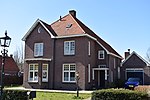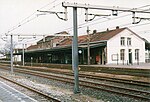Battle of Boxtel
Battles involving FranceBattles involving Great BritainBattles of the War of the First CoalitionBoxtelConflicts in 1794 ... and 1 more
French conquest of the Dutch Republic

The Battle of Boxtel was fought in the Duchy of Brabant on 14–15 September 1794, during the War of the First Coalition. It was part of the Flanders Campaign of 1793–94 in which British, Dutch and Austrian troops had attempted to launch an invasion of France through Flanders. It is often remembered as being the debut action of Arthur Wellesley, who later became the 1st Duke of Wellington.
Excerpt from the Wikipedia article Battle of Boxtel (License: CC BY-SA 3.0, Authors, Images).Battle of Boxtel
De Lange Loop, Boxtel
Geographical coordinates (GPS) Address Nearby Places Show on map
Geographical coordinates (GPS)
| Latitude | Longitude |
|---|---|
| N 51.583333333333 ° | E 5.3333333333333 ° |
Address
De Lange Loop
5283 BR Boxtel
North Brabant, Netherlands
Open on Google Maps









